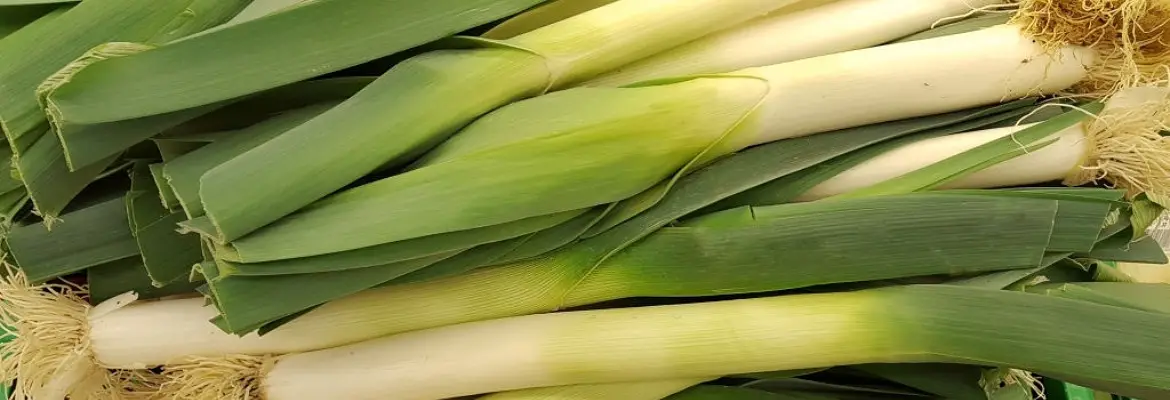Growing straight upwards from the ground, leeks have flat, overlapping leaves that grow up from a cylindrical, rounded bulb.
The leaves’ tops, which are called flags, are tough and dark green in colour with a bluish tint. As the leaves grow, they fan out up the stalk, like the fronds of a palm tree. Leaves on Leek can grow up to almost a meter tall. Approximately 3 – 4 inches long, the bulb lies shallow in the ground.
Leaf stalks have an average height of 30 to 35 centimeters (13 inches) and a diameter up to 5 centimeters and are light green in colour.
Leeks have a milder flavour than onions, with a slight sweetness to them. Raw leeks have a mild onion taste, while cooked leeks have a silky texture. Among the onion family, leeks are considered to be the sweetest and mildest.
In order to increase the length of the white portion of the bulb, growers pile soil around the bulb to restrict sunlight and chlorophyll production. This practice results in leeks accumulating a great deal of dirt between their leaves.
The leek belongs to the Allium family, which includes garlic and onions. The plants are biennial (requiring two growing seasons) but they are usually grown and harvested annually. Leeks are commonly used as a herb or to flavour foods, but they can also be cooked as a vegetable.
In addition to vitamins B6 and potassium, leeks also contain iron, manganese, and dietary fiber. Leeks are rich in folate (the highest concentration in the white part of the bulb), which is particularly beneficial for pregnant women.
Also, leeks contain sulfur and insulin, which reduce bad cholesterol and protect cells, respectively. Furthermore, they contain prebiotics, which helps to maintain healthy gut bacteria.
Scientific name of Leeks
Allium ampeloprasum
Other names of Leeks
- Allium porrum
- Broadleaf wild leek
- Garden leek
- English Leeks
- European Leeks
- Kurrat Leek
- Wild Leek
Nutrition facts of Leeks
*Serving size = 100 grams = 3.55 Ounces = 1/2 cup
*DV= % Daily Value (%DV indicates how much nutrients contribute to a person’s daily diet from a serving of a food. DV assists you in determining whether or not a serving of food is high or low in a particular nutrient.)
| Nutrient | Amount | Unit | DV |
|---|---|---|---|
| Calories | 61 | KCAL | |
| Fat | 0.3 | GRAM | 0% |
| Protein | 1.5 | GRAM | 3% |
| Carbohydrate | 14.15 | GRAM | 5% |
Calories by source in Leeks:
- Calories by carbohydrate in Leeks = 86%
- Calories by fat in Leeks = 4%
- Calories by protein in Leeks = 10%
Fats and Fatty Acid profile of Leeks:
- Polyunsaturated fat (PUFA) in Leeks = 79%
- Saturated fat (SFA) in Leeks = 19%
- Monounsaturated fat (MUFA) in Leeks = 2%
Detailed vitamin profile of Leeks, vitamin A, vitamin B12, vitamin B6, vitamin C, vitamin D, Folate, Niacin, Thiamin, and Riboflavin is shown in the chart at the end of the article.
Detailed mineral profile of Leeks, Sodium(Na), Calcium(Ca), Copper(Cu), Iron(Fe), Magnesium(Mg), Selenium(Se), Phosphorus(P), Potassium(K) and Zinc(Zn) is shown the chart at the end of the article.
Availability of Leeks
- Leeks are available round the year
Complete nutrition facts of Leeks
Click on the link HERE to download high quality, high resolution and print ready PDF version of the Leeks nutrition chart/infographic.



